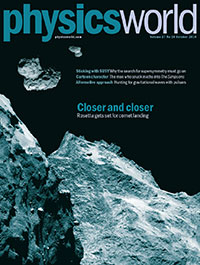By Matin Durrani
There’s some great material in the October issue of Physics World, which is out now in print and digital formats. Highlights include a look at Europe’s Rosetta mission, which is set to land a probe on a comet for the very first time, an analysis of whether pulsars could be used to detect gravitational waves, and a great feature by University of Maryland physicist James Gates, who insists that although CERN’s Large Hadron Collider has so far seen no signs of supersymmetry, the search for SUSY must go on.
Another great article in the issue is by my colleague Margaret Harris, who is Physics World‘s careers editor. She’s written an in-depth study of what we’re dubbing the “STEM shortage paradox”. This is the curious fact that many employers in the UK say they are struggling to find enough good people with science, engineering, technology and maths (STEM) backgrounds, whereas at the same time lots of physics graduates are finding it hard to get jobs. So is there a really a “STEM shortage”, or do STEM graduates have the wrong skills, aren’t good enough or want to work in other fields? In the video above, Margaret outlines her motivations for writing the article.
If you’re a member of the Institute of Physics (IOP), you can enjoy immediate access to the new issue with the digital edition of the magazine on your desktop via MyIOP.org or on any Apple device via the Physics World app, available from the App Store. (Please note that the new Android version of the app will be available later this month.) If you’re not yet in the IOP, you can join as an IOPimember for just £15, €20 or $25 a year to get a full year’s access to Physics World both online and through the apps.
 For the record, here’s a run-down of other highlights of the October issue.
For the record, here’s a run-down of other highlights of the October issue.
• A dangerous distraction – Seismologists are at odds over whether probabilistic forecasting of major earthquakes should be used to try and save lives, as Edwin Cartlidge reports
• Argentina shakes up physics education – Argentinians often view physics as a subject disconnected from the real world. But various initiatives are now seeking to modernize how the subject is taught using new technologies and by building bridges between academia and industry, as James Dacey finds out
• Lessons from Palestine – With the Middle East in turmoil, Kate Shaw says that we need to provide more support to physicists in the region
• Celebrating the mind – Robert P Crease celebrates the profound contributions of the
“recreational mathematician” Martin Gardner, who would have turned 100 this October
• Rendezvous with a comet – After making a successful rendezvous with Comet 67P/Churyumov–Gerasimenko earlier this year, Europe’s Rosetta craft is now riding alongside this celestial body and next month is set to land a probe on its surface. Matt Taylor describes the excitement of this unique project and the scientific insights that it hopes to achieve
• Sticking with SUSY – When CERN’s Large Hadron Collider failed to uncover evidence of new “superpartner” particles during its first run, some claimed that the theory that predicts them – known as supersymmetry, or SUSY – should be abandoned. S James Gates, Jr, however, argues that giving up on SUSY now would be like concluding that giant sequoia trees do not exist after surveying only the east coast of North America, and that there is more at stake than meets the eye
• Hunting gravitational waves with pulsars – With the first direct detection of gravitational waves at the top of many physicists’ wish list, Louise Mayor describes how radio astronomers are hoping to reveal these ripples in space–time by pointing their telescopes at an array of distant pulsars
• Unearthing Newton’s papers – Matin Durrani reviews The Newton Papers: the Strange and True Odyssey of Isaac Newton’s Manuscripts by Sarah Dry
• Stalin’s scientists – Asif Siddiqi reviews Buried Glory: Portraits of Soviet Scientists by Istvan Hargittai
• The STEM shortage paradox – The UK is believed to suffer from a shortage of scientists and engineers, yet unemployment rates for new graduates in these fields are high. Does that mean the skills shortage doesn’t exist, asks Margaret Harris
• Theories of quantum levity – Simon Singh on the man who snuck physics into The Simpsons
Trackback: Physics Viewpoint | The October 2014 issue of Physics World is now out
Very Interesting.